Analysis of Changes in Soil Organic Carbon, Energy Consumption and Environmental Impact Using Bio-Products in the Production of Winter Wheat and Oilseed Rape
Abstract
:1. Introduction
2. Materials and Methods
2.1. Site Description and Experiment Design
2.2. Biopreparations and Crop Production Technologies
2.3. Energy Assessment
2.4. GHG Assessment
2.5. Meteorological Conditions
2.6. Statistical Analysis
3. Results and Discussion
3.1. Soil Organic Carbon
3.2. Crop Yield
3.3. Energy Input/Output Analysis
3.4. GHG Emissions
4. Conclusions
Author Contributions
Funding
Acknowledgments
Conflicts of Interest
References
- Lal, R. Carbon sequestration. Philos. Trans. R. Soc. Lond. Ser. B Biol. Sci. 2008, 363, 815–830. [Google Scholar] [CrossRef] [PubMed]
- Briones, M.J.I.; Ostle, N.J.; Garnett, M.H. Invertebrates increase the sensitivity of non-labile soil carbon to climate change. Soil Biol. Biochem. 2007, 39, 816–818. [Google Scholar] [CrossRef]
- Benbi, D.K.; Chand, M. Quantifying the effect of soil organic matter on indigenous soil N supply and wheat productivity in semiarid sub-tropical India. Nutr. Cycl. Agroecosyst. 2007, 79, 103–112. [Google Scholar] [CrossRef]
- Shi, X.Z.; Yang, R.W.; Weindorf, D.C.; Wang, H.J.; Yu, D.S.; Huang, Y.; Pan, X.Z.; Sun, W.X.; Zhang, L.M. Simulation of organic carbon dynamics at regional scale for paddy soils in China. Clim. Chang. 2009, 102, 579–593. [Google Scholar] [CrossRef]
- Getahun, G.T.; Munkholm, L.J.; Schjønning, P. The influence of clay-to-carbon ratio on soil physical properties in a humid sandy loam soil with contrasting tillage and residue management. Geoderma 2016, 264, 94–102. [Google Scholar] [CrossRef]
- Lenka, N.K.; Jaiswal, S.P.; Thakur, J.K.; Lenka, S.; Mandal, A.; Dwivedi, A.K.; Yashona, D.S. Soil degradation effect on soil productivity, carbon pools and soil enzyme activity. Curr. Sci. 2017, 112, 2434–2439. [Google Scholar] [CrossRef]
- Bastioli, C.; Biro, B.; Bouma, J.; Cienciala, E.; Correia, T.P.; Emmett, B.; Filchev, L.H.; Frison, E.A.; Grand, A.; Veerman, C.; et al. Caring for Soil is Caring for Life: Ensure 75% of Soils Are Healthy by 2030 for Healthy Food, People, Nature and Climate: Interim Report of the Mission Board for Soil Health and Food: Study; Publications Office of the European Union: Luxembourg, 2020; p. 56. Available online: https://op.europa.eu/s/n8PT (accessed on 25 August 2020). [CrossRef]
- Qi, R.; Li, J.; Lin, Z.; Li, Z.; Li, Y.; Yang, X.; Zhao, B. Temperature effects on soil organic carbon, soil labile organic carbon fractions, and soil enzyme activities under long-term fertilization regimes. Appl. Soil Ecol. 2016, 102, 36–45. [Google Scholar] [CrossRef]
- Zhang, Y.; Cai, X.; Lv, J. Size and dynamics of soil organic carbon stock in cropland of the Eastern Qinghai-Tibetan Plateau. Agric. Ecosyst. Environ. 2016, 222, 125–132. [Google Scholar] [CrossRef]
- Barłóg, P.; Hlisnikovský, L.; Kunzová, E. Effect of digestate on soil organic carbon and plant-available nutrient content compared to cattle slurry and mineral fertilization. Agronomy 2020, 10, 379. [Google Scholar] [CrossRef] [Green Version]
- Yang, J.; Gao, W.; Ren, S. Long-term effects of combined application of chemical nitrogen with organic materials on crop yields, soil organic carbon and total nitrogen in fluvo-aquic soil. Soil Tillage Res. 2015, 151, 67–74. [Google Scholar] [CrossRef]
- Blair, N.; Faulkner, R.D.; Till, A.R.; Poulton, P.R. Long-term management impacts on soil C, N and physical fertility. Soil Tillage Res. 2006, 91, 30–38. [Google Scholar] [CrossRef]
- Banger, K.; Kukal, S.S.; Toor, G.; Sudhir, K.; Hanumanthraju, T.H. Impact of long-term additions of chemical fertilizers and farm yard manure on carbon and nitrogen sequestration under rice-cowpea cropping system in semi-arid tropics. Plant Soil 2009, 318, 27–35. [Google Scholar] [CrossRef]
- Jague, E.A.; Sommer, M.; Saby, N.P.; Cornelis, J.T.; van Wesemael, B.; van Oost, K. High resolution characterization of the soil organic carbon depth profile in a soil landscape affected by erosion. Soil Tillage Res. 2016, 156, 185–193. [Google Scholar] [CrossRef]
- Qaswar, M.; Jing, H.; Ahmed, W.; DongChu, L.; Shujun, L.; Lu, Z.; Huimin, Z. Yield sustainability, soil organic carbon sequestration and nutrients balance under long-term combined application of manure and inorganic fertilizers in acidic paddy soil. Soil Tillage Res. 2020, 198, 104569. [Google Scholar] [CrossRef]
- Liu, M.; Zhang, W.; Wang, X.; Wang, F.; Dong, W.; Hu, C.; Sun, R. Nitrogen leaching greatly impacts bacterial community and denitrifiers abundance in subsoil under long-term fertilization. Agric. Ecosyst. Environ. 2020, 294, 106885. [Google Scholar] [CrossRef]
- Johns, T.J.; Angove, M.J.; Wilkens, S. Measuring soil organic carbon: Which technique and where to from here? Soil Res. 2015, 53, 717–736. [Google Scholar] [CrossRef]
- Bisutti, I.; Hilke, I.; Raessler, M. Determination of total organic carbon—An overview of current methods. TrAC Trends Anal. Chem. 2004, 23, 716–726. [Google Scholar] [CrossRef]
- Ben-Dor, E.; Banin, A. Determination of organic matter content in arid-zone soils using a simple “loss-on-ignition” method. Commun. Soil Sci. Plant Anal. 1989, 20, 1675–1695. [Google Scholar] [CrossRef]
- Schwartz, V. Fractionated combustion analysis of carbon in forest soils—New possibilities for the analysis and characterization of different soils. Fresenius’ J. Anal. Chem. 1995, 351, 629–631. [Google Scholar] [CrossRef]
- Snyder, C.; Bruulsema, T.W.; Jensen, T.L.; Fixen, P.E. Review of greenhouse gas emissions from crop production systems and fertilizer management effects. Agric. Ecosyst. Environ. 2009, 133, 247–266. [Google Scholar] [CrossRef]
- N2O Emissions from Managed Soils, and CO2 Emissions from Lime and Urea Application. In Intergovernmental Panel on Climate Change Guidelines for National Greenhouse Gas Inventories; IPCC: Geneva, Switzerland, 2006; Volume 4, Available online: http://www.ipcc-nggip.iges.or.jp/public/2006gl/pdf/4_Volume4/V4_11_Ch11_N2O&CO2.pdf (accessed on 14 May 2020).
- International Fertilizer Industry Association and the Food and Agriculture Organization of the United Nations. Global Estimates of Gaseous Emissions of NH3, NO, and N2O from Agricultural Land; IFA/FAO: Rome, Italy, 2001; p. 106. Available online: http://www.fao.org/3/Y2780E/y2780e02.htm#P1_28 (accessed on 14 May 2020).
- Bouwman, A.F.; Boumans, L.J.M.; Batjes, N.H. Emissions of N2O and NO from fertilized fields: Summary of available measurement data. Glob. Biogeochem. Cycles 2002, 16, 1–6. [Google Scholar] [CrossRef]
- Perego, A.; Wu, L.; Gerosa, G.; Finco, A.; Chiazzese, M.; Amaducci, S. Field evaluation combined with modelling analysis to study fertilizer and tillage as factors affecting N2O emissions: A case study in the Po valley (Northern Italy). Agric. Ecosyst. Environ. 2016, 225, 72–85. [Google Scholar] [CrossRef]
- Rowlings, D.W.; Grace, P.R.; Scheer, C.; Kiese, R. Influence of nitrogen fertiliser application and timing on greenhouse gas emissions from a lychee (Litchi chinensis) orchard in humid subtropical Australia. Agric. Ecosyst. Environ. 2013, 179, 168–178. [Google Scholar] [CrossRef]
- Šarauskis, E.; Masilionytė, L.; Juknevičius, D.; Buragienė, S.; Kriaučiūnienė, Z. Energy use efficiency, GHG emissions, and cost-effectiveness of organic and sustainable fertilisation. Energy 2019, 172, 1151–1160. [Google Scholar] [CrossRef]
- Pratibha, G.; Srinivas, I.; Rao, K.V.; Raju, B.M.K.; Thyagaraj, C.R.; Korwar, G.R.; Srinivasarao, C. Impact of conservation agriculture practices on energy use efficiency and global warming potential in rainfed pigeonpea-castor systems. Eur. J. Agron. 2015, 66, 30–40. [Google Scholar] [CrossRef]
- Jat, H.S.; Jat, R.D.; Nanwal, R.K.; Lohan, S.K.; Yadav, A.K.; Poonia, T.; Jat, M.L. Energy use efficiency of crop residue management for sustainable energy and agriculture conservation in NW India. Renew. Energy 2020, 155, 1372–1382. [Google Scholar] [CrossRef]
- Unakıtan, G.; Aydın, B. A comparison of energy use efficiency and economic analysis of wheat and sunflower production in Turkey: A case study in Thrace Region. Energy 2018, 149, 279–285. [Google Scholar] [CrossRef]
- IUSS Working Group WRB. World Reference Base for Soil Resources 2014, Update 2015: International Soil Classification System for Naming Soils and Creating Legends for Soil Maps; World Soil Resources Reports FAO: Rome, Italy, 2015; Volume 106, p. 192. [Google Scholar]
- Mohammadi, A.; Rafiee, S.; Jafari, A.; Keyhani, A.; Mousavi-Avval, S.H.; Nonhebel, S. Energy use efficiency and greenhouse gas emissions of farming systems in north Iran. Renew. Sustain. Energy Rev. 2014, 30, 724–733. [Google Scholar] [CrossRef]
- Tabar, I.B.; Keyhani, A.; Rafiee, S. Energy balance in Iran’s agronomy (1990–2006). Renew. Sustain. Energy Rev. 2010, 14, 849–855. [Google Scholar] [CrossRef]
- Lin, H.C.; Huber, J.A.; Gerl, G.; Hülsbergen, K.J. Effects of changing farm management and farm structure on energy balance and energy-use efficiency—A case study of organic and conventional farming systems in southern Germany. Eur. J. Agron. 2017, 82, 242–253. [Google Scholar] [CrossRef]
- Tzilivakis, J.; Warner, D.J.; May, M.; Lewis, K.A.; Jaggard, K. An assessment of the energy inputs and greenhouse gas emissions in sugar beet (Beta vulgaris) production in the UK. Agric. Syst. 2005, 85, 101–119. [Google Scholar] [CrossRef] [Green Version]
- Tabatabaeefar, A.; Emamzadeh, H.; Varnamkhasti, M.G.; Rahimizadeh, R.; Karimi, M. Comparison of energy of tillage systems in wheat production. Energy 2009, 34, 41–45. [Google Scholar] [CrossRef]
- Ziaei, S.M.; Mazloumzadeh, S.M.; Jabbary, M. A comparison of energy use and productivity of wheat and barley (case study). J. Saudi Soc. Agric. Sci. 2015, 14, 19–25. [Google Scholar] [CrossRef] [Green Version]
- Reineke, H.; Stockfisch, N.; Märländer, B. Analysing the energy balances of sugar beet cultivation in commercial farms in Germany. Eur. J. Agron. 2013, 45, 27–38. [Google Scholar] [CrossRef]
- Kitani, O. Energy and biomass engineering. In CIGR Handbook of Agricultural Engineering Volume V; ASAE Publications: St. Joseph, MI, USA, 1999; p. 330. [Google Scholar]
- Ram, R.; Verma, A. Energy input, output and economic analysis in organic production of mango (Mangifera indica) cv. Dashehari. Indian J. Agric. Sci. 2015, 85, 827–832. [Google Scholar]
- Martin-Gorriz, B.; Soto-García, M.; Martínez-Alvarez, V. Energy and greenhouse-gas emissions in irrigated agriculture of SE (southeast) Spain. Effects of alternative water supply treatments. Energy 2014, 77, 478–488. [Google Scholar] [CrossRef]
- Pishgar-Komleh, S.H.; Omid, M.; Heidari, M.D. On the study of energy use and GHG (greenhouse gas) emissions in greenhouse cucumber production in Yazd province. Energy 2013, 59, 63–71. [Google Scholar] [CrossRef]
- Lal, R. Carbon emission from farm operations. Environ. Int. 2004, 30, 981–990. [Google Scholar] [CrossRef]
- Dyer, J.A.; Desjardins, R.L. Carbon dioxide emissions associated with the manufacturing of tractors and farm machinery in canada. Biosyst. Eng. 2006, 93, 107–118. [Google Scholar] [CrossRef]
- Gong, H.; Li, J.; Sun, M.; Xu, X.; Ouyang, Z. Lowering carbon footprint of wheat-maize cropping system in North China Plain: Through microbial fertilizer application with adaptive tillage. J. Clean. Prod. 2020, 268, 122255. [Google Scholar] [CrossRef]
- Biograce. Available online: https://www.biograce.net/content/ghgcalculationtools/standardvalues (accessed on 20 May 2020).
- Melillo, J.M.; Steudler, P.A.; Aber, J.D.; Newkirk, K.; Lux, H.; Bowles, F.P.; Morrisseau, S. Soil warming and carbon cycle feedbacks to the climate system. Science 2002, 298, 2173–2176. [Google Scholar] [CrossRef] [PubMed]
- Lefevre, R.; Barre, P.; Moyano, F.E.; Christensen, B.T.; Bardoux, G.; Eglin, T.; Chenu, C. Higher temperature sensitivity for stable than for labile soil organic carbon—Evidence from incubations of long-term bare fallow soils. Glob. Chang. Biol. 2014, 20, 633–640. [Google Scholar] [CrossRef] [PubMed]
- Hou, R.; Ouyang, Z.; Maxim, D.; Wilson, G.; Kuzyakov, Y. Lasting effect of soil warming on organic matter decomposition depends on tillage practices. Soil Biol. Biochem. 2016, 95, 243–249. [Google Scholar] [CrossRef]
- Artyszak, A.; Gozdowski, D. The effect of growth activators and plant growth-promoting rhizobacteria (PGPR) on the soil properties, root yield, and technological quality of sugar beet. Agronomy 2020, 10, 1262. [Google Scholar] [CrossRef]
- Tang, A.; Haruna, A.O.; Majid, N.M.A.; Jalloh, M.B. Effects of selected functional bacteria on maize growth and nutrient use efficiency. Microorganisms 2020, 8, 854. [Google Scholar] [CrossRef]
- Khoshnevisan, B.; Rafiee, S.; Omid, M.; Mousazadeh, H. Applying data envelopment analysis approach to improve energy efficiency and reduce GHG (greenhouse gas) emission of wheat production. Energy 2013, 58, 588–593. [Google Scholar] [CrossRef]
- Singh, P.; Singh, G.; Sodhi, G.P.S. Applying DEA optimization approach for energy auditing in wheat cultivation under rice-wheat and cotton-wheat cropping systems in north-western India. Energy 2019, 181, 18–28. [Google Scholar] [CrossRef]
- Canakci, M.; Topakci, M.; Akinci, I.; Özmerzi, A. Energy use pattern of some field crops and vegetable production: Case study for Antalya Region, Turkey. Energy Convers. Manag. 2005, 46, 655–666. [Google Scholar] [CrossRef]
- Yuan, S.; Peng, S.; Wang, D.; Man, J. Evaluation of the energy budget and energy use efficiency in wheat production under various crop management practices in China. Energy 2018, 160, 184–191. [Google Scholar] [CrossRef]
- Soni, P.; Taewichit, C.; Salokhe, V.M. Energy consumption and CO2 emissions in rainfed agricultural production systems of Northeast Thailand. Agric. Syst. 2013, 116, 25–36. [Google Scholar] [CrossRef]
- Khoshnevisan, B.; Rafiee, S.; Omid, M.; Yousefi, M.; Movahedi, M. Modeling of energy consumption and GHG (greenhouse gas) emissions in wheat production in Esfahan province of Iran using artificial neural networks. Energy 2013, 52, 333–338. [Google Scholar] [CrossRef]
- Singh, P.; Singh, G.; Sodhi, G.P.S. Energy and carbon footprints of wheat establishment following different rice residue management strategies vis-à-vis conventional tillage coupled with rice residue burning in north-western India. Energy 2020, 200, 117554. [Google Scholar] [CrossRef]
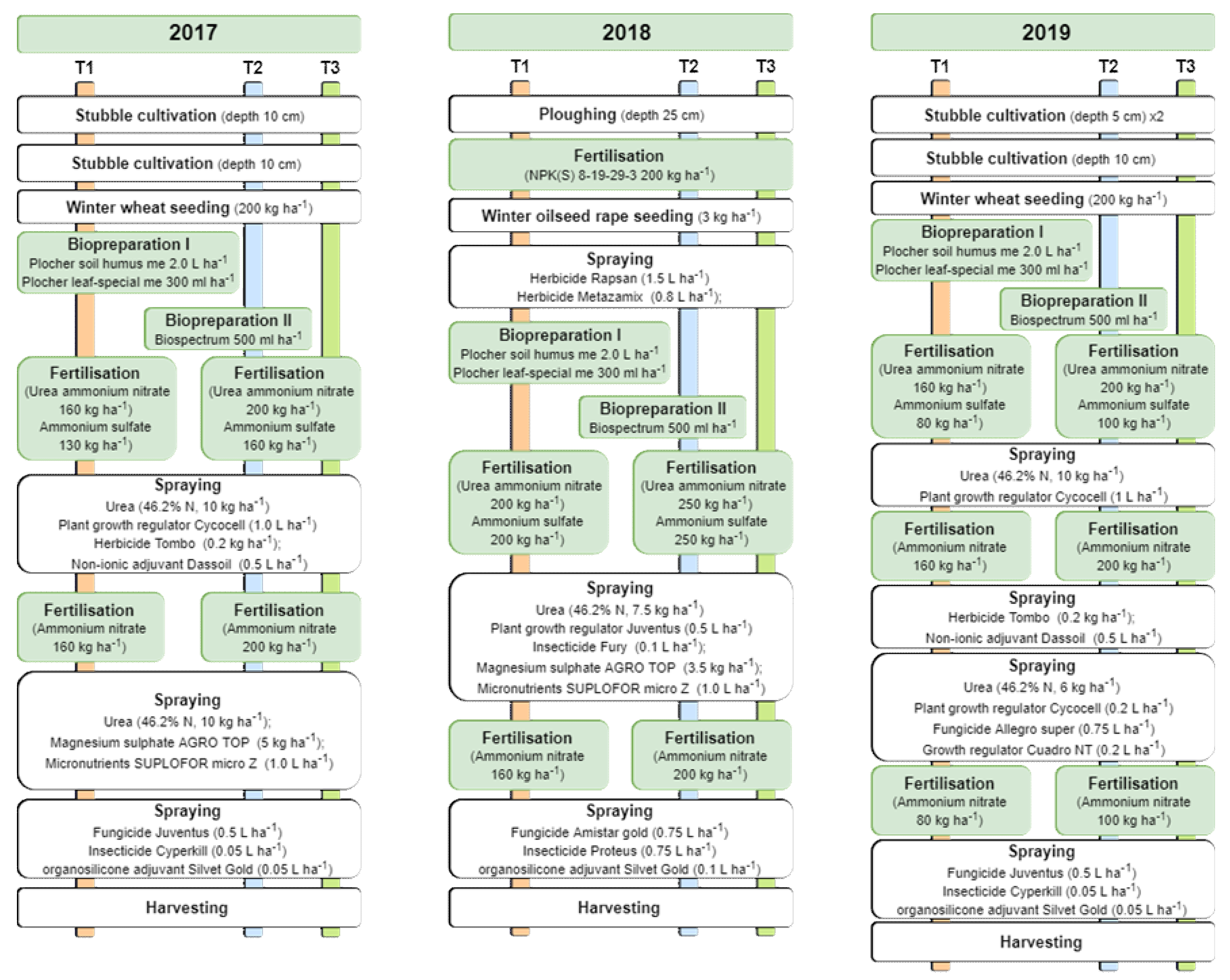
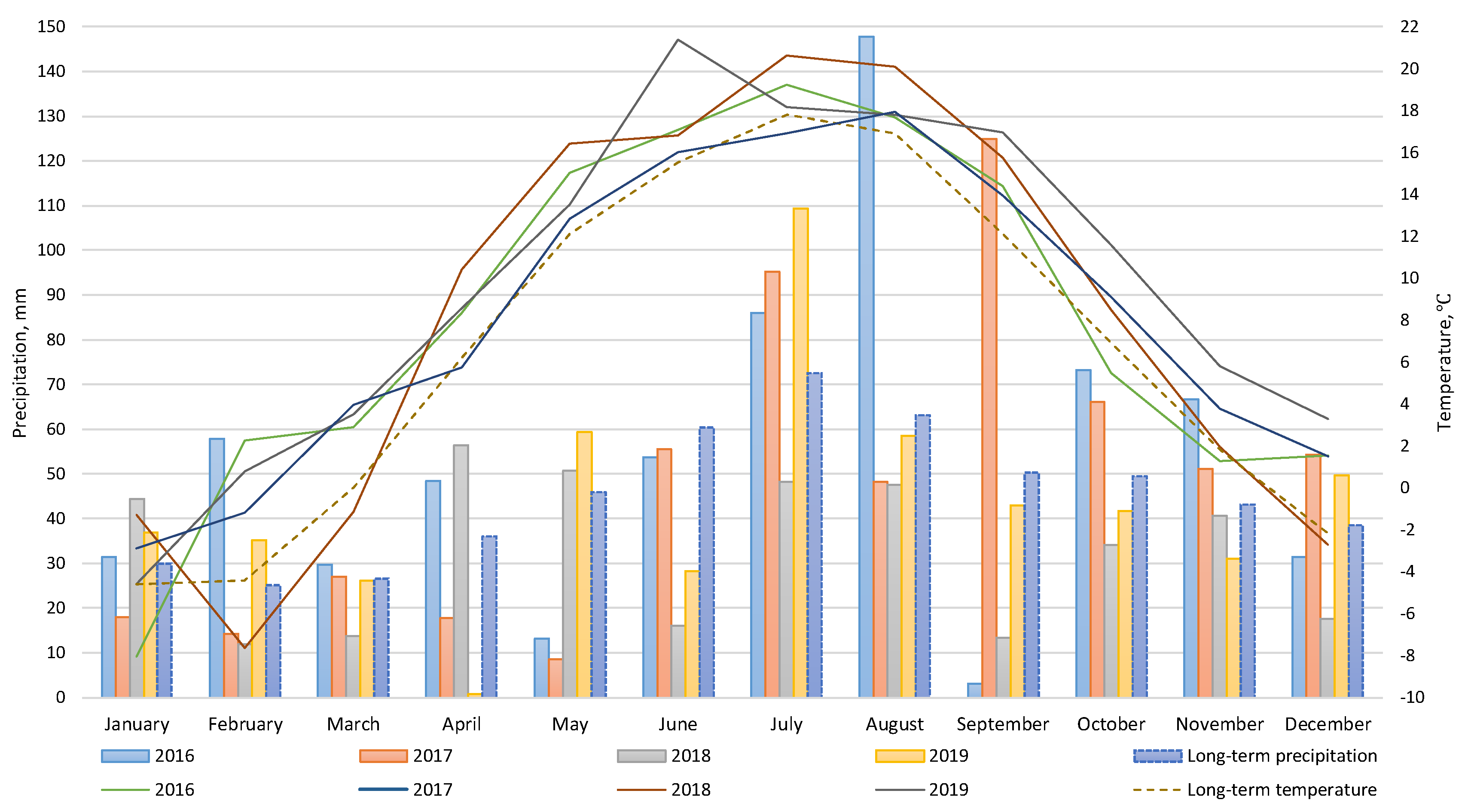
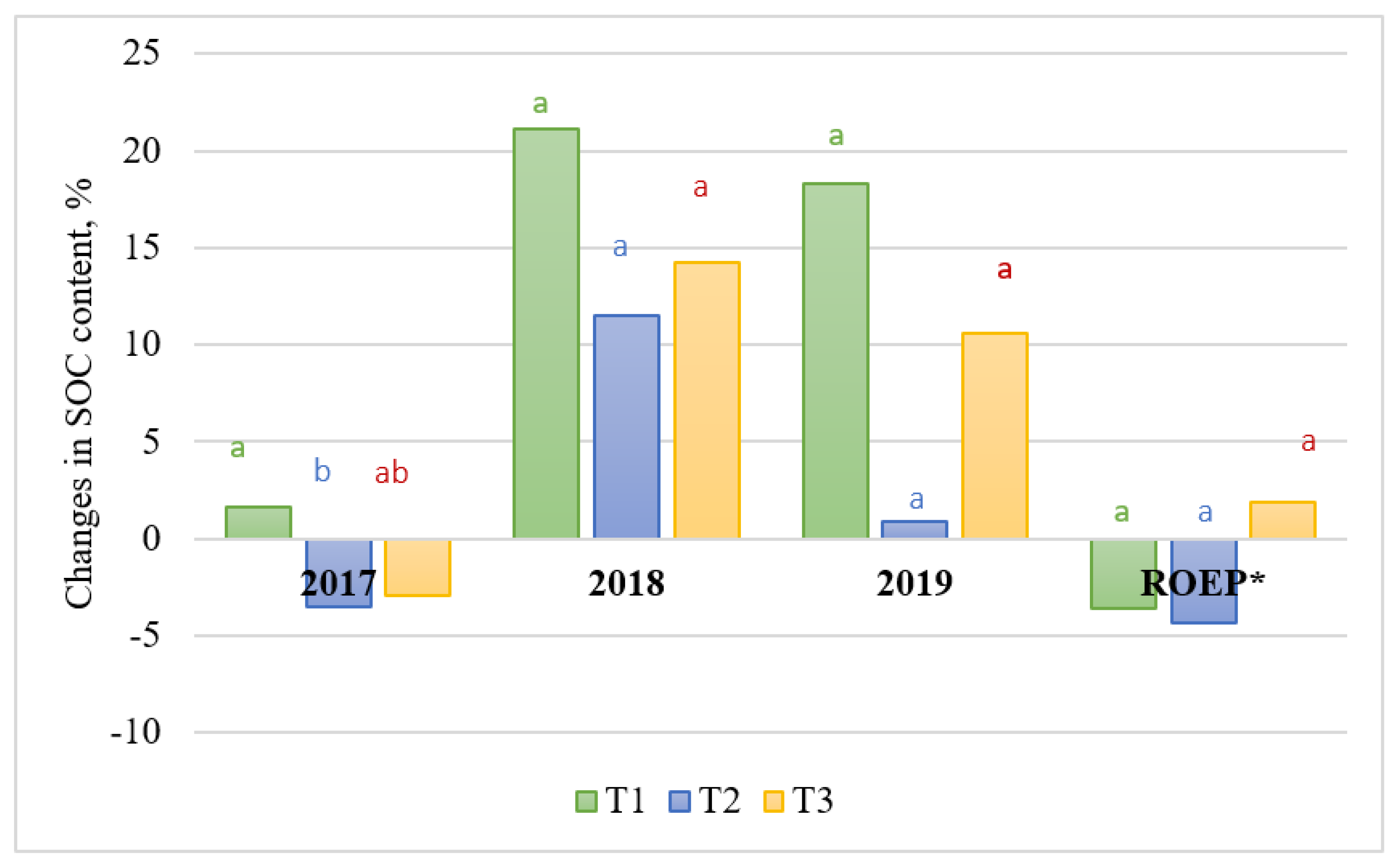
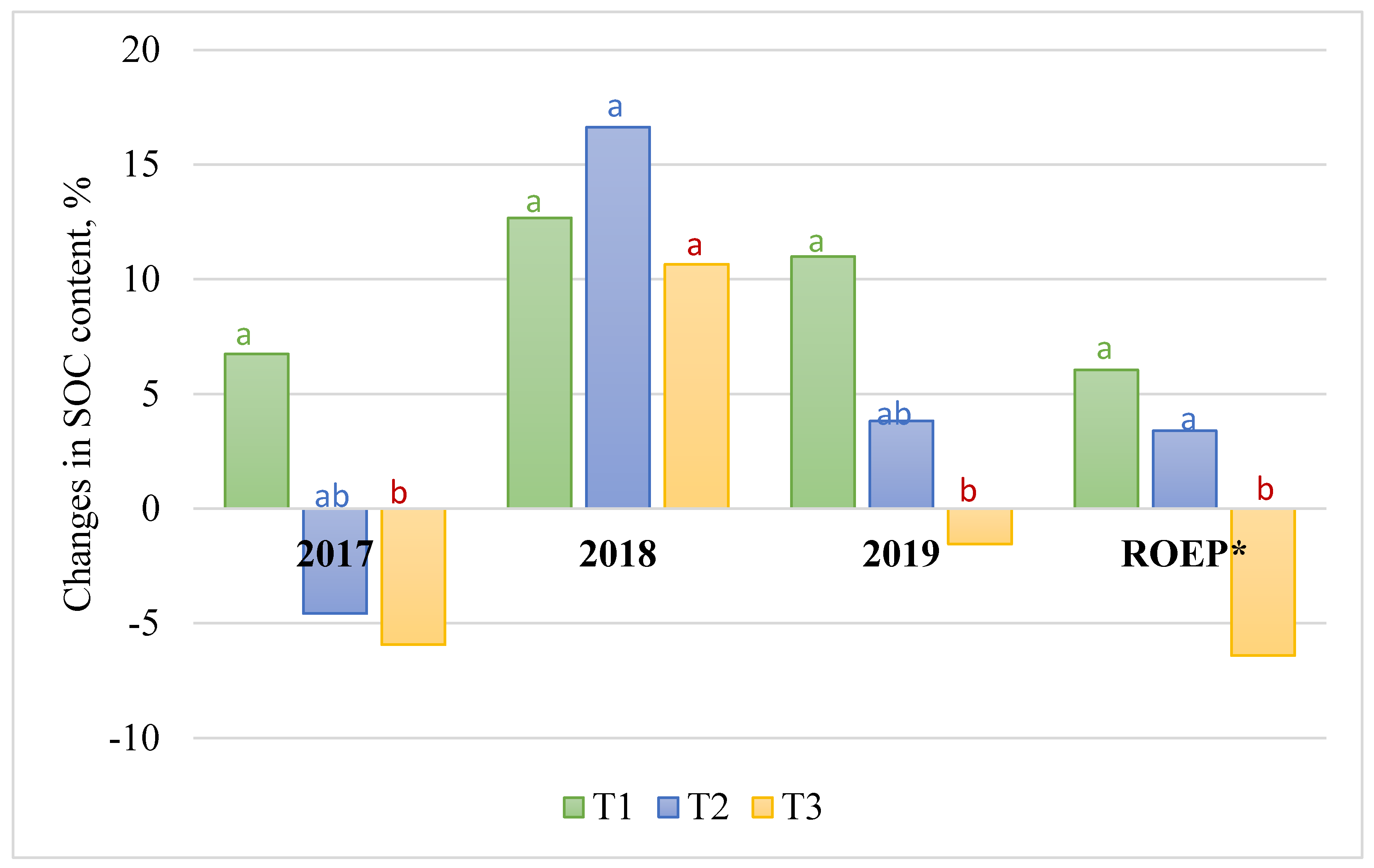
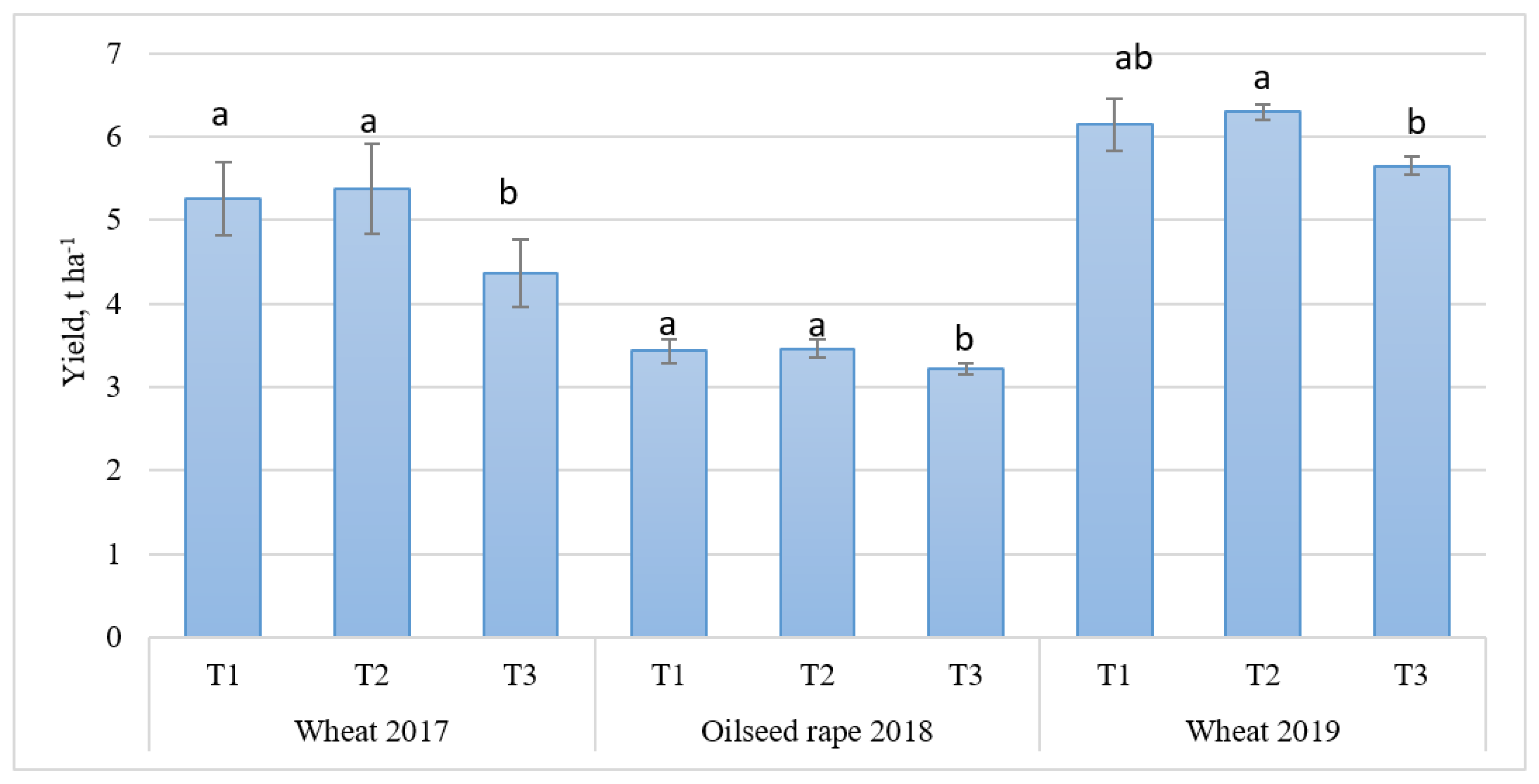
| Input/Output (Unit) | Energy Equivalent | References |
|---|---|---|
| Input Human labor (MJ h−1) | 1.96 | [33] |
| Diesel fuel (MJ L−1) | 39.6 | [34,35] |
| Agricultural machinery (including self-propelled machines) (MJ h−1) | 357.2 | [36] |
| Wheat seed (MJ kg−1) | 14.7 | [37] |
| Oilseed rape (OSR) seed (MJ kg−1) | 20.1 | [36,37] |
| N fertilizer (MJ kg−1) | 40.0 | [38] |
| P fertilizer (MJ kg−1) | 15.8 | [38] |
| K fertilizer (MJ kg−1) | 9.3 | [38] |
| Herbicide (MJ kg−1) | 85.0 | [39] |
| Fungicide (MJ kg−1) | 295.0 | [39] |
| Insecticide (MJ kg−1) | 115.0 | [39] |
| Biopreparation (MJ kg−1) | 10.0 | [40] |
| Output Wheat grain yield (MJ kg−1) Oilseed rape yield (MJ kg−1) | 14.48 14.70 | [36] [37] |
| Agricultural Input (Unit) | Emission Equivalent | Reference |
|---|---|---|
| Machinery (kg CO2eq MJ−1) | 0.071 | [43,44] |
| Diesel fuel (kg CO2eq L−1) | 2.76 | [42] |
| N fertilizer (kg CO2eq kg−1) | 1.3 | [42,43] |
| P fertilizer (kg CO2eq kg−1) | 0.2 | [42,43] |
| K fertilizer (kg CO2eq kg−1) | 0.15 | [42,43] |
| S fertilizer (kg CO2eq kg−1) | 7.3 | [43] |
| Herbicide (kg CO2eq kg−1) | 6.3 | [32] |
| Fungicide (kg CO2eq kg−1) | 5.1 | [32] |
| Insecticide (kg CO2eq kg−1) | 3.9 | [32] |
| Biopreparation (kg CO2eq kg−1) | 4.3 | [45] |
| OSR seed (kg CO2eq kg−1) | 0.17 | [46] |
| Wheat seed (kg CO2eq kg−1) | 0.11 | [46] |
| Treatments | Depth, cm | SOC Content, % | |||||
|---|---|---|---|---|---|---|---|
| 2017 | 2018 | 2019 | |||||
| Spring | Autumn | Spring | Autumn | Spring | Autumn | ||
| T1 | 0–10 | 2.00 | 2.03 | 1.78 | 2.16 | 1.64 | 1.93 |
| 10–20 | 1.84 | 1.93 | 1.89 | 2.12 | 1.73 | 1.92 | |
| T2 | 0–10 | 1.78 | 1.72 | 1.85 | 2.04 | 1.71 | 1.72 |
| 10–20 | 1.78 | 1.69 | 1.85 | 2.14 | 1.77 | 1.83 | |
| T3 (Control) | 0–10 | 2.12 | 2.06 | 2.03 | 2.31 | 2.03 | 2.15 |
| 10–20 | 2.14 | 2.00 | 2.04 | 2.25 | 1.98 | 1.99 | |
| Year | Treatment | Fertilizer MJ ha−1 | Total Energy Input MJ ha−1 | Total Energy Output MJ ha−1 | Energy Efficiency Ratio | Energy Productivity kg MJ−1 | Specific Energy MJ kg−1 | Net Energy MJ ha−1 |
|---|---|---|---|---|---|---|---|---|
| 2017 | T1 | 10,501 | 17,983 | 77,276 | 4.30 | 0.292 | 3.42 | 59,293 |
| T2 | 13,126 | 20,591 | 79,066 | 3.84 | 0.261 | 3.83 | 58,476 | |
| T3 | 13,126 | 20,586 | 64,170 | 3.12 | 0.212 | 4.72 | 43,585 | |
| 2018 | T1 | 12,368 | 18,325 | 93,723 | 5.11 | 0.187 | 5.34 | 75,398 |
| T2 | 15,460 | 21,399 | 94,585 | 4.42 | 0.162 | 6.18 | 73,186 | |
| T3 | 15,460 | 21,394 | 88,001 | 4.11 | 0.151 | 6.64 | 66,607 | |
| 2019 | T1 | 11,259 | 18,671 | 90,451 | 4.84 | 0.330 | 3.03 | 71,780 |
| T2 | 14,073 | 21,468 | 92,649 | 4.32 | 0.294 | 3.41 | 71,181 | |
| T3 | 14,073 | 21,463 | 83,082 | 3.87 | 0.263 | 3.80 | 61,619 |
| Greenhouse Gas Emissions kg CO2eq Mg−1 | |||||||||
|---|---|---|---|---|---|---|---|---|---|
| Year | 2017 | 2018 | 2019 | ||||||
| Treatment | T1 | T2 | T3 | T1 | T2 | T3 | T1 | T2 | T3 |
| Fuel | 33.22 | 32.47 | 40.00 | 59.36 | 58.82 | 63.22 | 23.92 | 23.35 | 26.04 |
| Agricultural machinery | 13.49 | 13.18 | 16.24 | 26.72 | 26.48 | 28.46 | 12.91 | 12.60 | 14.06 |
| Seed Wheat | 10.65 | 10.41 | 12.83 | - | - | - | 9.10 | 8.89 | 9.91 |
| Seed OSR | - | - | - | 0.64 | 0.63 | 0.68 | - | - | - |
| Herbicides | 0.84 | 0.82 | 1.01 | 4.22 | 4.18 | 4.50 | 0.72 | 0.70 | 0.78 |
| Insecticides | 0.04 | 0.04 | 0.04 | 0.97 | 0.96 | 1.03 | 0.03 | 0.03 | 0.03 |
| Fungicides | 1.50 | 1.47 | 1.81 | 3.86 | 3.83 | 4.11 | 2.07 | 2.02 | 2.26 |
| Biopreparations | 1.88 | 0.40 | 0.00 | 2.88 | 0.62 | 0.00 | 1.61 | 0.34 | 0.00 |
| Nitrogen | 35.53 | 43.41 | 53.49 | 64.98 | 80.48 | 86.51 | 34.14 | 41.66 | 46.46 |
| Phosphate | 1.34 | 1.64 | 2.02 | 2.05 | 2.54 | 2.73 | 1.43 | 1.75 | 1.95 |
| Potassium | 1.32 | 1.62 | 1.99 | 2.03 | 2.51 | 2.70 | 0.00 | 0.00 | 0.00 |
| Sulphur | 49.33 | 60.26 | 74.25 | 112.27 | 139.06 | 149.47 | 22.78 | 27.80 | 31.00 |
| Total fertilizers | 89.40 | 107.32 | 131.74 | 184.21 | 225.22 | 241.40 | 59.96 | 71.55 | 79.41 |
| Total input | 149.14 | 165.71 | 203.68 | 279.98 | 320.12 | 343.40 | 108.71 | 119.14 | 132.48 |
© 2020 by the authors. Licensee MDPI, Basel, Switzerland. This article is an open access article distributed under the terms and conditions of the Creative Commons Attribution (CC BY) license (http://creativecommons.org/licenses/by/4.0/).
Share and Cite
Juknevičius, D.; Kriaučiūnienė, Z.; Jasinskas, A.; Šarauskis, E. Analysis of Changes in Soil Organic Carbon, Energy Consumption and Environmental Impact Using Bio-Products in the Production of Winter Wheat and Oilseed Rape. Sustainability 2020, 12, 8246. https://doi.org/10.3390/su12198246
Juknevičius D, Kriaučiūnienė Z, Jasinskas A, Šarauskis E. Analysis of Changes in Soil Organic Carbon, Energy Consumption and Environmental Impact Using Bio-Products in the Production of Winter Wheat and Oilseed Rape. Sustainability. 2020; 12(19):8246. https://doi.org/10.3390/su12198246
Chicago/Turabian StyleJuknevičius, Darius, Zita Kriaučiūnienė, Algirdas Jasinskas, and Egidijus Šarauskis. 2020. "Analysis of Changes in Soil Organic Carbon, Energy Consumption and Environmental Impact Using Bio-Products in the Production of Winter Wheat and Oilseed Rape" Sustainability 12, no. 19: 8246. https://doi.org/10.3390/su12198246
APA StyleJuknevičius, D., Kriaučiūnienė, Z., Jasinskas, A., & Šarauskis, E. (2020). Analysis of Changes in Soil Organic Carbon, Energy Consumption and Environmental Impact Using Bio-Products in the Production of Winter Wheat and Oilseed Rape. Sustainability, 12(19), 8246. https://doi.org/10.3390/su12198246






